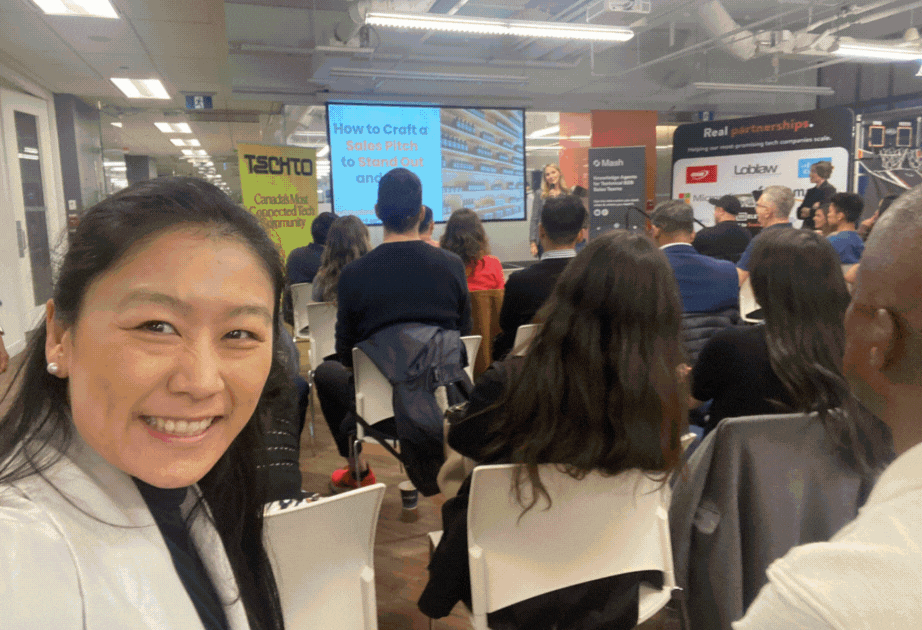When I left my corporate job to start Zenful Sales, I had a dream: to create more time and energy for my charity, which is my life mission and passion project. I knew I could sell (I’d generated over $10M in B2B revenue) but I had zero clients, no marketing materials, no case studies, and honestly, no clear idea of what specific problem I solved.
I couldn’t even explain what I did concisely. I initially introduced myself as a sales coach, combining life coaching with sales coaching. People got confused, they even thought I offered a course to teach them sales techniques. Then I tried “sales consultant,” but that was a saturated market with stigmas around that category. It took dozens of conversations to land on language that actually resonated.
7 months later, I had 11 clients and was fully booked.
Here’s the messy, uncertain reality of how I went from zero clients to fully booked.
The Truth About Starting from Nothing
Most advice assumes you have something: a network, a clear message, existing relationships. I had none of that. Each networking event wasn’t just about finding clients; it was about discovering what problem I actually solved (that and making friends while having fun at it :).
Every conversation taught me something:
- Which problems made people lean in (founder-dependency in sales)
- Which ones got blank stares (generic “sales improvement”)
- What price points made people interested vs. running away
- How to explain my value in terms they actually cared about
Eight Ways Founders Find First Customers (When Starting from Zero)
Through my journey and working with other founders, I’ve seen eight patterns emerge. These aren’t “growth hacks.” They’re relationship-intensive approaches that work precisely because they’re inefficient.
1. Embed Yourself in Their World
The Approach: Work directly in your customer’s environment to understand their reality firsthand.
Real Example: Mave’s CEO (AI assistant for real estate agents) Raz Zohar worked as an executive assistant for seven real estate agents for an entire month, it gave him anxiety as he shared. He experienced their exact pain points, earned their trust through excellent work, and they became his first customers.
Why It Works: You can’t fake understanding when you’re doing the actual work. Plus, great work builds trust faster than any pitch.
What It Really Takes: Work alongside at least 3-5 different potential customers for minimum one week each. Raz worked for a full month – that’s the level of depth that yields genuine insights. A day or two of observation won’t reveal the real pain points that only surface through repetition and edge cases.
2. Share Your Authentic Journey
The Approach: Document your learning process publicly, including the uncertainty and real experiences as they happen.
Real Example: I was too busy talking to prospects to create a content strategy. I just posted on LinkedIn about what I was experiencing in real-time: event summaries from Toronto Tech Week, celebrating obtaining my Professional Certified Coach designation while nursing my baby, speaking engagements at YSpace and Toronto Business Development Centre. I shared the moments as they happened – the inspiring panels, the connections made, even the perks of finding a quiet TechTO member lounge between events. These weren’t strategic content pieces; they were genuine snapshots of building a business while living a full life. People reached out – former colleagues who saw my journey, new connections who resonated with the challenges I was navigating. Several became clients without me ever pitching them.
Why It Works: Real-time authenticity beats polished content. People connect with someone actively building, learning, and sharing the experience as it unfolds.
What It Really Takes: Post genuinely when you have something to share – could be weekly, could be after every major event or realization. No content calendar needed, but you need at least 3-4 months of visible activity before people start recognizing your journey and reaching out.
3. Become a Regular at Industry Events
The Approach: Attend events consistently, focusing on understanding rather than selling.
Real Example: I went to countless events, sometimes even multiple events in a week. Many were complete misses: wrong audience entirely. But each conversation helped refine my message. When I genuinely believed I could help someone, I’d offer to continue the conversation. This naturally led to about 3 follow-up meetings per good event. After numerous events, I knew exactly where my people gathered.
Why It Works: Repetition builds recognition. Helping builds trust. Trust builds business.
What It Really Takes: Commit to 2-3 months of consistent attendance, hitting 8-12 events minimum before you know which ones have your people. Expect to have 30-40 follow-up conversations to yield your first 3-5 customers.
4. The Barter Trade Strategy
The Approach: Exchange your services for others’ services or products, especially when cash flow is tight.
Real Example: I did barter trades with some early clients, exchanging my sales consulting for their services. This reduced the risk for both sides, let me prove value without them spending cash, and some of these barter relationships converted to paying clients later.
Why It Works: Lower barrier to entry for both parties. You get case studies and testimonials while they get help without cash outlay.
What It Really Takes: Reach out to 10-15 businesses to find 3-5 good barter matches. Many won’t be interested or won’t need what you offer. The successful trades often convert to paying arrangements within 2-3 months.
5. The Research Conversation Pivot
The Approach: Interview potential customers about their challenges with zero mention of selling anything.
Real Example: ProfitWell’s Patrick Campbell interviewed 50 SaaS founders about pricing “for research.” Pure curiosity, no agenda. Only at the end: “I’m actually building something for this. Interested?” 30% said yes immediately.
Why It Works: You’ve demonstrated understanding before pitching. The conversation feels helpful, not salesy.
What It Really Takes: Conduct 30-50 research interviews to yield 5-10 interested prospects. Patrick Campbell did 50 interviews – that’s a realistic benchmark. Expect 20-30% interest rate at best when you reveal what you’re building.
6. Contribute to Online Communities
The Approach: Become genuinely helpful in specific communities for months before mentioning your business.
Real Example: Zapier’s Wade Foster spent 6+ months answering automation questions in forums before ever mentioning Zapier. He became known as “the automation guy” through hundreds of helpful responses. When he finally shared Zapier, the community already trusted his expertise. First customers came from those relationships built through consistent value delivery over many months.
Why It Works: Earned authority beats claimed authority every time. But earning that authority takes real time and consistent presence.
What It Really Takes: Make 100+ helpful contributions over 4-6 months minimum. You need to be top-of-mind when someone has the problem you solve. This is the slowest method on this list but builds the strongest trust.
7. Teach What You Know
The Approach: Run workshops or give talks about the problem space, positioning yourself as an educator rather than a vendor.
Real Example: Before launching Drift (conversational marketing AI-chatbot), David Cancel spent 6 months speaking at marketing conferences about the philosophy of conversational marketing. He wasn’t pitching a product (it didn’t exist yet), he was sharing a vision for how marketing should work. When Drift finally launched, CMOs from those talks became customers because they had already bought into his way of thinking about the problem.
Why It Works: Teaching positions you as the expert. People buy from experts whose perspective they trust.
What It Really Takes: Run at least 5-6 workshops or presentations over 3-4 months before you’re seen as an authority. One workshop won’t position you – you need repeated exposure to the same or overlapping audiences.
8. Experience Their Business First
The Approach: Become a customer of your potential customers before reaching out, so you can speak from genuine experience about their business.
Real Example: The founders of Gorgias (customer service software) would actually buy products from e-commerce stores, go through their entire customer journey, and experience their support process firsthand. Then they’d reach out to founders with specific observations: “I bought your product and noticed it took 3 days to get a response to my question. Here’s how that might be impacting your retention.” This personal investment and specific insight led to a 40% meeting acceptance rate.
Why It Works: You’re not guessing about their problems, you’ve experienced them. The specificity and effort show genuine interest.
What It Really Takes: Experience 15-20 businesses to identify patterns and have enough specific insights for personalized outreach. You need multiple data points to make your observations valuable, not just one-off complaints.
A Warning About Wrong-Fit Early Customers
Not all first customers are good customers. Taking anyone who’ll pay can send you building in the wrong direction for years.
Your first 5 should be people you’d want 100 of. If they’re not in your ideal target market, their feedback will pull you off course. I learned this the hard way – some of my early barter clients needed things I didn’t actually want to build long-term, and saying yes to them delayed my clarity by months.
Ask yourself: If this person’s needs defined my entire business, would I be excited or exhausted? Choose the ones who make you excited to solve their problems.
What Nobody Tells You About First Customers
Your first customers aren’t buying your product or service. They’re buying your commitment to figuring it out with them.
Each client helped me refine what I was actually selling. But each client had different problems, they were in different stages of their businesses, and each one contributed to clarify my positioning.
By client #11, I finally had clarity: I help founder-led B2B companies combine sales execution, founder psychology, and technical systems to build predictable revenue.
The Transition Point (And What Comes Next)
By July, I was fully booked but the intensity wasn’t sustainable long-term. The same activities that found my first 11 clients weren’t efficient for the next 100. That’s when I had to shift from relationship-intensive discovery to systematic execution.
The patterns from those first 11 clients revealed:
- My ideal client profile (founder-led B2B, $500K-$2M revenue)
- The core problems I solved (founder-dependency, failed sales hires)
- The messages that resonated (“systematic vs. random”)
- Where to focus my energy (specific events and communities)
Once you have 5-10 customers, you can start analyzing these patterns and building scalable systems. This is the critical transition most founders miss: the methods that get you started aren’t the ones that help you scale. But you can’t skip the messy beginning. It’s where you discover what you’re actually building.
Starting from Zero Is the Advantage
Looking back, starting with nothing was actually my advantage. No assumptions to unlearn. No bad habits to break. Every conversation was pure discovery.
If you’re at zero right now (no clients, unclear message, uncertain pricing) you’re exactly where you need to be. The clarity comes through action, not planning. Your first customers are out there, waiting to help you figure out what you’re really selling.
Just start having conversations. The rest will follow.
Wherever you are in your journey, whether you’re still figuring things out or ready to scale—I’m happy to help. Book 15 minutes with me at https://calendly.com/laneylui/zenful-sales and let’s talk about your next step.





